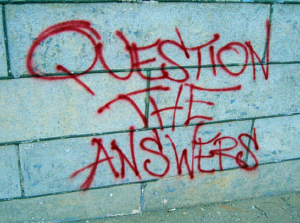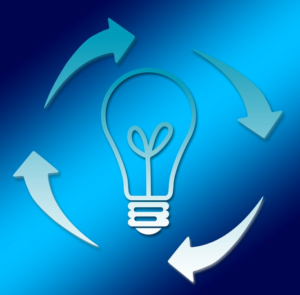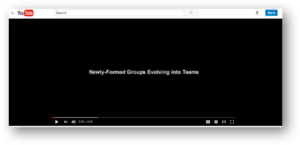| by Blake Harvard, James Clemens High School |
Downloadable |
Motivation for Activity
I am very lucky to work at a high school with students who are quite focused and, from the standpoint of intelligence, very gifted. This does not make them great learners though. I realize a lot of my students clearly benefit from being able to memorize information. This may work in high school, where assessments are given sometimes daily. In college, however, this will not work. Assessment of material may consist of a midterm and a final. As a teacher who wants to better prepare my students for a lifetime of learning, I am motivated to introduce and cultivate learning strategies that focus on this personal growth and better understanding of their own learning through specific exercises promoting metacognition.
Context for Activity
I use this activity with my high school AP Psychology classes. These classes average about 30 students. Although my situation is quite specific, I believe this activity can easily be accommodated to fit most class sizes in almost all disciplines of study.
Description of Activity
Let me put all the cards out on the table: I am a big believer in using researched/proven learning strategies promoting metacognition to improve retention of classroom material. I have applied strategies in my high school Advanced Placement Psychology classes and seen notable improvements in three areas:
- Test scores
- Study habits
- Student’s understanding of their learning
Improvement in test scores is important for many reasons and ultimately describes an overall level of understanding. While I am thrilled to see my mean test score increase and standard deviation shrink a bit, that is not what I’m most excited about when lauding learning strategies. I am far happier with the student growth with respect to their study habits and metacognition about their learning. While I instruct highly intelligent adolescents, most of my students do not enter my room as great learners. They are merely great memorizers. There’s nothing inherently wrong with that, but it becomes much more difficult to just memorize your way through college and most of my students (80% to 90%) will attend university.
In particular, one learning strategy that I believe to be the most effective is retrieval practice. The Learning Scientists provide a great overview of the strategy. Basically, the idea is to attempt to retrieve information from your memory a bit after it’s been presented to you. This can be done minutes, hours, or days later, and can be seen in many forms: multiple-choice or matching questions, essays,. I have written before on the topic of retrieval practice and its impact on my classroom. Today, I want to focus on how I promote metacognition through the use of retrieval practice in my classroom.
Usually the day after a lesson, I use these steps to practice retrieval of the information:
- Provide questions or a prompt. Since I am preparing my students for an AP exam in May, I usually provide AP style questions (no more than 7). By ‘AP style’, I mean, either multiple-choice questions with five possible answers or an essay prompt requiring students use terms or concepts from the previous lesson to successfully relate their knowledge to a given scenario.
- Answer using only their brain. This step starts to break their habit of asking those around them for help or looking at their notes/the internet for assistance. In my opinion, this step is the most important aspect of retrieval practice. They are forced to attempt to retrieve material as they practice answering test questions, which is the process in which they will have to engage during the actual test. A second benefit is that this practice can help to reduce test anxiety. A lot of students shy away from this step because it can be difficult or because it highlights flaws in their learning, but I tell my students it’s definitely better to struggle with the material now than on the test. If the test is the first time a student is presented with material in a way that utilizes the use of retrieval practice, we’ve all probably failed.
- Evaluate their answers. How many answers are they very confident with? How many answers are simply guesses? I want students to understand that if they just guessed and answered correctly, they still don’t know the answer, they just got lucky. Sometimes I’ll have my students delineate, by using a different color pen on their paper, answers they are confident with and those they are not. This helps them to visualize their pre-grade understanding.
- Compare/contrast answers with neighbors. I instruct the students to have a conversation; debate any discrepancies. At this point, if they can thoughtfully discuss answers they probably have a decent grasp of the information and have taken time to reflect on their learning; specifically where their may be holes in their learning of the material or with what they thought they knew, but may have been mislead.
- Grade their paper. After students grade their paper I want them thinking about the following questions that really allow the students to practice their metacognition and regulate/reinforce their study habits for future practice.
a. Does my grade reflect my knowledge?
b. Am I happy with my grade?
c. If no to either of the above questions, what strategies can I utilize to successfully retain the material? At this point, many students incorrectly believe that their understanding of material is complete…for better or worse. You can almost see them thinking either “Oh well, I just don’t know this” or “I scored well, I must know this”. I attempt to impress upon my students that use of other strategies, like spaced practice and dual coding, will further aid to improve and solidify retention of the material.
d. If yes to the above questions, I ask students to reflect on what work they put in to remember this material so they can plan to use that strategy again for future learning. This step also helps reinforce that they should focus on learning strategies, not just guessing / luck.
Reflection
After many semesters of working with students, I have come to believe that metacognition and reflection on study habits/strategies is of foundational importance. One of the goals I have for the students in my class, over the course of a semester, is these learning strategies become their norm for studying. It’s not something extra, it is what they do to practice and learn. Without the reflection piece of using retrieval practice and other learning strategies, it is hard for high school students to examine their study/practice growth. While walking the students through these five steps may seem a little laborious, the explicitness of the instructions seems to work well to increase their awareness of their own learning shape their behaviors toward more effective practices.
It is often quite difficult to convince teenagers their study/practice habits, that usually rely on simple memorization, will more than likely not be successful at college. They need to see results from their added efforts. Using these five steps, I have witnessed student’s grades improve and study/practice habits change for the better. As a teacher, I’m not sure it gets any better…improving a student’s learning and making them more successful. It’s why we get paid the big bucks. 🙂
References
Learn How to Study Using…Retrieval Practice, The Learning Scientists, www.learningscientists.org
Retrieval Practice in the High School Classroom, The Effortful Educator, www.effortfuleducator.com
Learn How to Study Using…Spaced Practice, The Learning Scientists, www.learningscientists.org
Learn How to Study Using…Dual Coding, The Learning Scientists, www.learningscientists.org
 many teachers would choose “go with your gut instinct”, otherwise known as the First Instinct Fallacy (Kruger, Wirtz, & Miller, 2005). In this well-known article by Kruger and colleagues, they found (in 4 separate experiments) that when students change their answers, they typically change from incorrect to correct answers, they underestimate the number of changes from incorrect to correct answers, and overestimate the number of changes from incorrect to correct. Ironically, but not surprisingly, because students like to “go-with-their-gut”, they also tend to be very hesitant to switch their answers and regret doing so, even though they get the correct answer. However, what Kruger and colleagues did not investigate was the role that metacognition may play in the First Instinct Fallacy.
many teachers would choose “go with your gut instinct”, otherwise known as the First Instinct Fallacy (Kruger, Wirtz, & Miller, 2005). In this well-known article by Kruger and colleagues, they found (in 4 separate experiments) that when students change their answers, they typically change from incorrect to correct answers, they underestimate the number of changes from incorrect to correct answers, and overestimate the number of changes from incorrect to correct. Ironically, but not surprisingly, because students like to “go-with-their-gut”, they also tend to be very hesitant to switch their answers and regret doing so, even though they get the correct answer. However, what Kruger and colleagues did not investigate was the role that metacognition may play in the First Instinct Fallacy. (whether they knew it or guessed the answer), and to indicate whether or not they changed their initial answer. Consistent with Kruger et al. (2005) results, Couchman and colleagues found that students more often change their initial response from incorrect to correct answers than the reverse. What was interesting is that when students thought they knew the answer and didn’t change their answer, they were significantly more likely to get the answer correct (indicating higher metacognition). When students guessed, and didn’t change their answer, they were significantly more likely to get the answer incorrect (indicating low metacognition). Moreover, when compared to questions students thought they knew, when students revised guessed questions, they choose the correct answer significantly more often than when they didn’t change their answer. In other words, students did better on questions when they guessed and changed their answer to when they thought they knew the answer and changed their answer. These results suggested that students were using the metacognitive construct of cognitive monitoring to deliberately choose when to revise their answers or when to stick with their gut on a question-by-question basis.
(whether they knew it or guessed the answer), and to indicate whether or not they changed their initial answer. Consistent with Kruger et al. (2005) results, Couchman and colleagues found that students more often change their initial response from incorrect to correct answers than the reverse. What was interesting is that when students thought they knew the answer and didn’t change their answer, they were significantly more likely to get the answer correct (indicating higher metacognition). When students guessed, and didn’t change their answer, they were significantly more likely to get the answer incorrect (indicating low metacognition). Moreover, when compared to questions students thought they knew, when students revised guessed questions, they choose the correct answer significantly more often than when they didn’t change their answer. In other words, students did better on questions when they guessed and changed their answer to when they thought they knew the answer and changed their answer. These results suggested that students were using the metacognitive construct of cognitive monitoring to deliberately choose when to revise their answers or when to stick with their gut on a question-by-question basis. indicate a judgment of confidence for each question on the test (either use a categorical judgment such as low vs. medium vs. high confidence or use a 0-100 confidence scale). Then, if students are low in their confidence, instructors should encourage them to change or revise their answer. However, if student confidence is high, they should consider not changing or revising their answer. Interestingly enough, this must be done in real-time, because if students make this confidence judgment at post-assessment (i.e., at a later time), they tend to be overconfident and inaccurate in their confidence ratings. Thus, the answer to the First Instinct Fallacy is—like most things—complicated. However, don’t just respond with a simple “it depends”—even though you are correct in this advice. Go the step further and explain and demonstrate how to improve adaptive control and cognitive monitoring.
indicate a judgment of confidence for each question on the test (either use a categorical judgment such as low vs. medium vs. high confidence or use a 0-100 confidence scale). Then, if students are low in their confidence, instructors should encourage them to change or revise their answer. However, if student confidence is high, they should consider not changing or revising their answer. Interestingly enough, this must be done in real-time, because if students make this confidence judgment at post-assessment (i.e., at a later time), they tend to be overconfident and inaccurate in their confidence ratings. Thus, the answer to the First Instinct Fallacy is—like most things—complicated. However, don’t just respond with a simple “it depends”—even though you are correct in this advice. Go the step further and explain and demonstrate how to improve adaptive control and cognitive monitoring.










